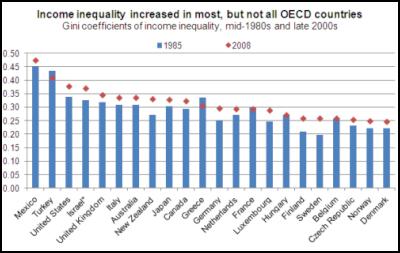Record gap between rich and poor
Society: Governments must tackle record gap between rich and poor, says OECD
05/12/11 - The gap between rich and poor in OECD countries has reached its highest level for over over 30 years, and governments must act quickly to tackle inequality, according to a new OECD report.
“Divided We Stand: Why Inequality Keeps Rising” finds that the average income of the richest 10% is now about nine times that of the poorest 10 % across the OECD.
The income gap has risen even in traditionally egalitarian countries, such as Germany, Denmark and Sweden, from 5 to 1 in the 1980s to 6 to 1 today. The gap is 10 to 1 in Italy, Japan, Korea and the United Kingdom, and higher still, at 14 to 1 in Israel, Turkey and the United States.
In Chile and Mexico, the incomes of the richest are still more than 25 times those of the poorest, the highest in the OECD, but have finally started dropping.
Income inequality is much higher in some major emerging economies outside the OECD area. At 50 to 1, Brazil's income gap remains much higher than in many other countries, although it has been falling significantly over the past decade.

Download the underlying data in Excel
[Scoop copy]
Launching the report in Paris, OECD
Secretary-General Angel Gurría said “The social contract
is starting to unravel in many countries. This study dispels
the assumptions that the benefits of economic growth will
automatically trickle down to the disadvantaged and that
greater inequality fosters greater social mobility. Without
a comprehensive strategy for inclusive growth, inequality
will continue to rise.”
The main driver behind
rising income gaps has been greater inequality in wages and
salaries, as the high-skilled have benefitted more from
technological progress than the low-skilled. Reforms to
boost competition and to make labour markets more adaptable,
for example by promoting part-time work or more flexible
hours, have promoted productivity and brought more people
into work, especially women and low-paid workers. But the
rise in part-time and low-paid work also extended the wage
gap.
Tax and benefit systems play a major role in reducing market-driven inequality, but have become less effective at redistributing income since the mid-1990s. The main reason lies on the benefits side: benefits levels fell in nearly all OECD countries, eligibility rules were tightened to contain spending on social protection, and transfers to the poorest failed to keep pace with earnings growth.
As a result, the benefit system in most countries has become less effective in reducing inequalities over the past 15 years.
Another factor has been a cut in top tax rates for
high-earners.
“There is nothing inevitable about high
and growing inequalities,” said Mr Gurría. “Our report
clearly indicates that upskilling of the workforce is by far
the most powerful instrument to counter rising income
inequality. The investment in people must begin in early
childhood and be followed through into formal education and
work.”
The OECD underlines the need for governments to review their tax systems to ensure that wealthier individuals contribute their fair share of the tax burden. This can be achieved by raising marginal tax rates on the rich but also improving tax compliance, eliminating tax deductions, and reassessing the role of taxes in all forms of property and wealth, the report says.
Download the two-page country notes for Australia, Canada, France (en Français & English), Germany, Italy (in Italian & English), Japan (in Japanese & English), Mexico (in Spanish & English), Spain (in Spanish & English), the United Kingdom and the United States (+ data)
More information about Divided We Stand, including a four-page summary, is available at www.oecd.org/els/social/inequality
ENDS
Scoop
copies of some documents:
4An
Overview of Growing Income Inequalities in OECD Countries
(PDF)
Underlying
data from key figures (XLS)
Media
brief
(PDF)


 Global Strategic Communications Council: One Year After Signing The Tripling Pledge, Governments’ Targets Are Unchanged, Even As Solar’s Prospects Are Upgraded
Global Strategic Communications Council: One Year After Signing The Tripling Pledge, Governments’ Targets Are Unchanged, Even As Solar’s Prospects Are Upgraded UN Climate Change: Financing The Future - Vera Songwe’s Vision For A Climate And Growth Agenda At COP29
UN Climate Change: Financing The Future - Vera Songwe’s Vision For A Climate And Growth Agenda At COP29 Glasgow Actions: At COP29, Global Activists Urge Strong Climate Finance Deal By Transforming Baku's Olympic Stadium Into Call For Action
Glasgow Actions: At COP29, Global Activists Urge Strong Climate Finance Deal By Transforming Baku's Olympic Stadium Into Call For Action Climate Action Network: COP29 - Repression Epidemic Regarding Climate Activists And Human Rights Defenders
Climate Action Network: COP29 - Repression Epidemic Regarding Climate Activists And Human Rights Defenders Demand Climate Justice DCJ: Climate Justice Groups Condemn COP29’s Carbon Markets Decision - Corporate Profits vs People’s Interests
Demand Climate Justice DCJ: Climate Justice Groups Condemn COP29’s Carbon Markets Decision - Corporate Profits vs People’s Interests UN News: COP29 - Push For Agreement On A New Climate Finance Deal ‘Right From The Start’
UN News: COP29 - Push For Agreement On A New Climate Finance Deal ‘Right From The Start’